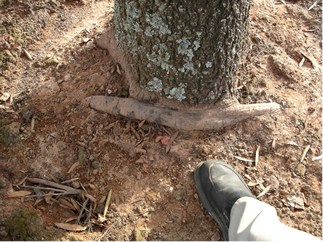 Description: Girdling root is defined as “a root that grows around the trunk of a tree, thus tending to strangle the tree”. Normal movement of water and nutrients from the roots to the crown may be significantly reduced, leading to stress and then to decline. If not disrupted, these circling roots can strangle the tree as it grows larger.
Description: Girdling root is defined as “a root that grows around the trunk of a tree, thus tending to strangle the tree”. Normal movement of water and nutrients from the roots to the crown may be significantly reduced, leading to stress and then to decline. If not disrupted, these circling roots can strangle the tree as it grows larger.
Girdling root most commonly occurs in maples, especially Norway maples. Young Norway maples have an average of 4 girdling roots per tree when examined a few years after transplanting. Sugar and Red maples have similar numbers. However, the Sugar and Red maples girdling roots are not nearly as large or advanced. This would explain their vigorous canopies as compared to the Norway maple.
When plants are grown in containers, roots can circle around the interior of the pot. Urban trees that were balled and burlapped are also susceptible to girdling roots. Placing the main stem base below the natural soil line will encourage the growth of advantageous roots that tend to encircle the tree below ground. Make sure trees are not planted too deep or that too much mulch isn’t placed over the planting hole. Mulch should never touch the trunk. Some trees develop girdling roots under the mulch pile.
Symptoms: A sign that a tree may have a girdling root is that one side of the trunk is flattened at the soil line, or if the trunk enters the ground, straight in, as a fence post would. The tree may start to thin out or when leaves show early autumn color. Also, if entire top branches die back quickly, girdling root is a possibility.
Action: Girdling roots can be exposed by the same process used to remove excess soil from trees planted too deeply. All of the soil and mulch in contact with the root collar must be removed. Root collar/girdling roots can be found by carefully using small digging tools and a brush. An alternate way is by using a compressed air device to blow the excess dirt away. Girdling roots are exposed and a plan can be formed to remove them.
When girdling roots are found early they can be quickly removed. However, within a few years of removing a girdling root on a young tree, one or more new girdling roots consistently regenerate from each root removal site.
After removing a large girdling root, the tree will show signs of stress before a full recovery. Keep the tree watered and talk to your arborist about soil therapy applications to speed up the recovery process.
Thank you for reviewing this information. Schneider Tree Care is committed to preserving and enhancing the quality of your property through tree care education and services. We employ professionally trained and certified arborists who are available to meet with you for a consultation at no charge.
If you have any questions or need additional information regarding the health of your trees, please contact us.





